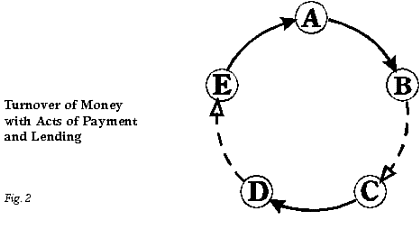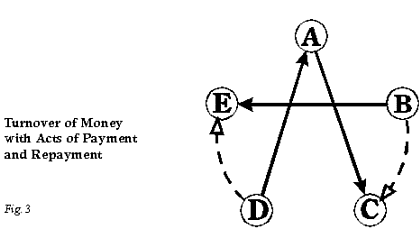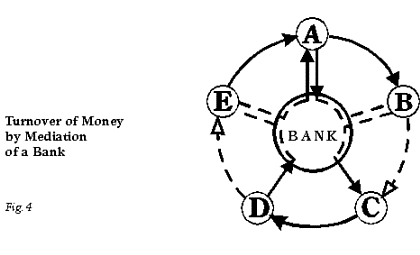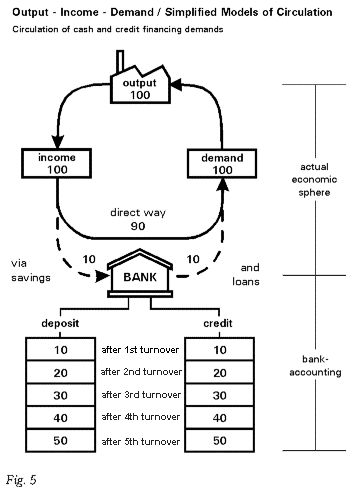The Enigma of the 5 DM Coin
The following story I found on the entertainment page of a magazine:In the saw-dust of the circus-ring the clown found a shiny 5 DM coin. He went to the stableboy and said: "I owe you ten Marks, here you have 5 DM for the time being, then I owe you only five more."Even though the story might look confusing at first glance, it describes nothing but a series of repayment acts with a circulating 5 Mark coin. That the story starts off with a coin that had been found, is only meant to increase irritation. The clown might have earned those 5 Marks just as well as stolen them or received as a gift. After the second rotation all the debts would have vanished even with a forged 5 Mark coin.
The stableboy thanked him, went to his foreman and said: "I am owing you ten Marks; here are five and then I owe you only five more."
The foreman thanked him and went to the horse trainer and said: "I owe you ten Marks, here are five Marks and then I owe you only five more." The horse trainer thanked him and went to the director and said: "Mr. Director, I owe you ten Marks, if you please, here are five Marks and then I owe you only five more."
The director thanked him and took the clown aside and told him: " Here I give you five Marks, the other five you will get later."
The clown thanked, gave 5 Marks to the stableboy and said: "Now we are quits."
The stableboy repaid his remaining debts to the foreman, the foreman to the horse trainer and the horse trainer to the director. The director took the clown aside and said: "Here, clown, are the 5 Marks, which are still due to you."
In this way the clown got his 5 DM coin back and everybody else got rid of his debts...Yet the story is not only about the disappearance of the debts of the five persons involved, but also the disappearance of credits of the same amount. For the debt of the clown to the stableboy was countered by a reciprocal credit of the stableboy to the clown a.s.o.
By this story, we can realize that circulating money can not only countlessly be used for purchasing but countless times for lending and repayments, too. But just as little as the amount of money had changed in the described chain of repayments, so little is its change in a chain of granted credits. Only the funds of credits and debts change which arise from the lending of money and dissolve with their repayment.
How to Understand Circulation?
In a circle there is no beginning and no end. Once a bill has been put into circulation it can run around with no end, no matter what purpose it is being used for. Let's clarify this in simple models with five participants:

A purchases from B.- B doesn't need the received money and lends it to C. - C purchases from D. - D lends it to E, who in turn pays a service he receives from A. Thus, the rotating bill was used three times for purchases and twice for lending. If B had not lent out his surplus, then the following acts would not have been possible. This simple example shows again the risks, which result from holding money back.
In the next model of circulation the debts get repaid:
A buys from C, who repays his debt to B. - B purchases from E, who repays his debt to D, who in turn purchases from A. Again the circle is closed and can start anew at random sequence.

Nothing in principle changes in these acts even though loans and repayments are performed by mediation of a bank. Not even when payments in cash and transfers of deposits would alternate:

A deposits the bill on a bank account and buys by check from B. - B purchases from C and pays by transferring the credit item he had received from A. - C withdraws this credit item and buys from D with cash. - D deposits the money at the bank again and purchases from E by bank transfer. E demands a service from A and in exchange transfers the credit item he had received from D. Since A is momentarily short of cash, he withdraws the amount from his account.
In this case the money was deposited twice at the bank and withdrawn twice, once a charge got balanced by cash and four times a credit item was transferred. The bank can use the funds which result from deposits for granting loans ensuing in an interim extension of the credit potential which will be dealt with more closely in Part V.
Which Consequences May Arise from Savings?
The consequences of savings are also to be considered within a limited frame and with comprehensible figures. Imagine an island with ten inhabitants, each of whom brings work into the market of 2'000 Marks worth every month and whose demands also amount to 2'000 Marks. If you further assume that the money turns over twice a month, then for making all the business on the island 10'000 Marks will be necessary. If this is regularily spent, then the circulation on the island will be stable, just as the business prospects. Everyone can sell services up to the same amount as his demands are. With a saturated demand a growth of the economy is not necessary.Let us now survey the case of an inhabitant of the island who, just like everybody else, receives 2'000 Marks per month for his work, but only demands services for 1'800 Marks, thus withholding 200 Marks every month. Which consequences may arise from these savings?
Case 1 - The saver gives his surplus of 200 Marks regularily away as a gift:
If the receiver of the gift spends the money just as regularly, then the market on the island will remain fully balanced. The receiver, so to speak, demands the services which the saver has brought in beyond his own demand. In the long run the wealth of the receiving one will increase compared to all others, the wealth of the giving one decreases.Case 2 - The saver gives his surplus of 200 Marks regularily away as a loan:
The situation of the market on the island and also the shifting of wealth is the same as in Case 1. Yet, because of the open demand of repayment the lender's asset will grow from month to month while the borrower's debt will reciprocally grow. After one year both figures have risen to 2'400 Marks, after ten years to 24'000 Marks. That means, after ten years money assets and debts amount to 2.4 times as much as all the circulating money on the island which doesn't exceed, as we know, 10'000 Marks.Case 3 - The saver gives his surplus away as a loan and collects interest:
At first (!) nothing changes in the market on the isle, the circulation of money and the business prospects. But the borrower of money is not only obliged to promise the repayment of the loan but in addition to that must pay a »loan tax« every month. He can only subtract this from his monthly income. With an interest rate of 10% this loan tax will sum up to 20 Marks after one year and to 200 Marks after ten years. These permanently increasing interest charges are countered by permanently increasing interest revenues of the lender. If he continues to live a frugal life, he can in addition to the monthly savings of 200 Marks lend out a permanently increasing amount from his interest revenues.Case 4 - The saver accumulates the surplus at home:
By this the money circulation on the island will be deprived of 200 Marks every month. After ten months the saver has already accumulated 2'000 Marks, one fifth of all the circulating money. After 50 months, i.e. little more than four years, theoretically all the money of the island would be in the hands of the saver.
Of course, things will not develop that far, because the monthly increasing lack of money would long before that result in a crash of the economy on the island.
What Can We Learn from the Examples of the Island?
Like the examples 1, 2 and 3 show, in an economy money can not only be saved, given away or lent out, but it must be done and the money must be put back into circulation or the economy - as shown in example 4 - will collapse.As examples 1, 2 and 3 also show, does the temporary lending out of money not increase the amount of money, only the size of assets and debts. Those could theoretically grow to infinity without an influence on the amount of money. In examples 2 and 3 with mounting debts the debtor becomes less and less able to pay them back. He will become more and more dependant on the money-lender. He must mortgage more and more assets to the money-lender and the end of this progression is, that all the debtor's property, including his house and land, now belongs to the money-lender. In former times he ended then in the »debtor's prison« or as »chattel« of his creditor. Today it is ›only‹ bankruptcy and attachment of further income.
To borrow money without interest will hardly ever lead to such problems. Normally, nobody will save money all the time and nobody will borrow it likewise. These processes end and get turned around and in any case they ›only‹ increase in a linear fashion, i.e. with steady pace. In example 3, however, by compound interest the debts grow with increasing speed. If the interest paying debtor doesn't want to starve, he must try to produce more and also be able to sell his increased output. If a third does not want to have his service unsold, there must be a common growth of demand and consumption on the island, which, if prices ought to remain stable, must be accompanied with an increased issuing of money by the bank of the island. Lending money and asking for interest has a built-in self-feeding effect which leads to a steadily growing difference between poor and rich. And when the debtor is at a stage where he must, only in order to pay the interest on his debts, make new debts, the process cannot be turned around anymore. We do not only observe this in Latin-America today, but in uncountable companies, private households, too, and above all, in the indebtments of most states.
To borrow money with interest is only useful for a debtor, when he can invest the money into something which brings an added profit on top of the interest. Macro-economically it depends on steady economic growth which has to be at least as high as the interest fed growth of monetary assets, that have to be pulled back into circulation by debts. Borrowing with interest is only without problems, if creditor and debtor - at shifting times - are the same person. This means that they get as much interest as they pay. This is the case with building societies and their banks, where the level of interest rates therefore is irrelevant.
Is There Any Difference in the Circulation of Money
All the examples which we have been playing through with small amounts of money and a limited number of persons also applies to every national economy. The number of bank notes, participants, payments or credit transfers may be in the millions: the basic workings are the same, they only get more obscure.
When Applied to a Bigger Economy?The following model shows such a cycle including output, income and demand. The best way is to imagine such a cycle with a turnover of 100 billions in a month. When the income resulting from production is fully spent, the market will be emptied. Everybody keeps his labor and therefore his income.
We will assume in this model, that everybody who collects income will save 10% of this income. This means, that only 90% of the total income is spent directly and in this way will become demand. If the savers give their surplus to the banks and the banks are able to give these deposits to others as credit the full demand is secured. If this money had not been given away as credit 10% of the output would stay unsold on the market. The result would be a downturn of the economy with unemployment and business failures.
As the lower part of the graphic shows, after the first month there are 10 billions in the banking sector. Not considering the small amount of remaining cash in the banks, there are also 10 billions of outstanding credit. Assuming the same level of savings (10%) the deposits will grow every month by 10 billions and after five months will already have reached half the size of all income and demand.
Here also it becomes clear that even with the same output, income and demand levels the monetary assets and debts can grow ever bigger without influencing the amount of money and its circulation. But »under the surface« the tension grows stronger and stronger, especially if credit is connected with interest payments as the example on the island has already shown. With a steadily growing economy these tensions can be softened for a while but not indefinitely. Considering the dangers to the environment through steady economic growth the end is already in sight.
